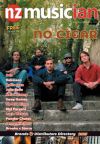Death and the Maiden: Temporarily So
Death and the Maiden: Temporarily So
Although conceived as more of a recording act, Death and the Maiden have been playing their intriguing brand of gothic techno-electronica around Dunedin for the last few years. On a suitably gothic Dunedin day (rain, hail and thunder) Amanda Mills met Danny Brady and bass player Lucinda King to talk about their (untitled) upcoming debut album, stuff that happens and what’s been flying at None.
Death and the Maiden formed in early 2012, after keyboardist Danny Brady moved into the residential artist and studio space None Gallery, where Lucinda King (who plays bass) was living. Pretty soon they started to create music, and were quickly joined by guitarist Hope Robertson, who has played alongside King since they were 17, and joins her in another of Dunedin’s bubbling-under-the-surface bands, the shoegazey Bad Sav.
The experimental noise scene at None Gallery has been happening for about 10 years. Brady sees it as influential.
“There’s no way you can have that around you all the time [and not] find its way into your own work.”
King finds the environment good for collaboration.
“If you feel like making music, you can just go down the hall and knock on the door, and say, ‘Wanna make something?’ and it happens.”
The name Death and the Maiden brings many things to mind, especially regarding local popular music history. Rather than the Verlaines’ song, they are named after Edvard Munch’s painting of Death embracing a maiden. While they have considered changing the moniker (purely out of frustration for the wrong kind of attention) they decided against it.
“We just kind of ended up sticking with it, realising that we shouldn’t let such a thing affect us,” says Brady. “I guess lots of other things relate to Death and the Maiden, we felt we’ll get to the point where we don’t care very much!”
Alongside the influence of the local noise scene, both King and Brady cite the more mainstream American electronic band, The Chromatics, as a sonic touchstone, especially their song Lady. King also cites Liz Harris’ ambient, dream pop work as inspirational, in particular her first CD-R release, ‘Grouper’. One more widely known band that comes to mind when listening to them is The Cure. King agrees, especially about their basslines.
“I got quite obsessive with… ‘Disintegration’ Brady admits. “I got all the outtakes… it’s really interesting, hearing all the processes.”
They have been recording their own first album since 2012, the creation spread out over about 7-8 months. Self-produced, the album was recorded in Brady’s bedroom and studios at None Gallery. Having discarded a number of tracks along the way they finally had a complete album.
Compact at seven songs, the record has a backbone of beats that are hypnotic and danceable at once. Dear ____ in particular is ethereal, with King’s shimmery, treated vocals floating over the drum track. The pair are vague on the exact themes touched upon, but describe the album as being about (in King’s words) “…stuff that happens.” Brady says audiences can hear the band reflecting on the changes and experiences they have been through over the last two years. He admits relief that the album is finished.
“I definitely had come across the problem of recording an album, and sitting on it far too long. The whole process of recording it… releasing it, and seeing it… realised my dream.”
‘It’ because the album is untitled, the trio taking a minimalist approach.
“We just didn’t feel like the album title was necessary for some reason. It might make sense for the second one.”
The album will be released through Fishrider and UK label Inoculation in February next year.
Of the album tracks, Flowers for the Blind is already familiar, as it appeared on Fishrider Records’ recent ‘Temporary ‘ compilation. The song is indebted to dance music, which Brady readily acknowledges his love of.
“I probably spend the majority of my time listening to techno,” he says, admitting the album is really just a blend of their tastes, particularly with Hope and Lucinda.
“I think that was a pleasant accident of me wanting to make something dancey and techno-ish.”
Starting with drums and bass, their music is built around layered textures. King provides the bass, lyrics and vocal lines. Guitar/vocalist Robertson does the guitar parts and Brady the keys, as well as producing and programming their drum machine.
Robertson’s talents are also used as drummer, though lately they’ve used the drumming skills of Dominic Stones (Birds Nest Roys, 3Ds) in their live shows to replicate the album’s drum parts. The trio have played live regularly, a concept Brady thinks strange as he says he always imagined them being more of a recording project. Though viewed as conventional by their peers, Brady and King see themselves as part of the city’s noise/experimental scene.
“It’s sort of weird… we’re mashed in between them – people have definitely given me a lot of shit for being poppy and mainstream,” Brady laughs. “I think that our sound is poppy and mainstream compared to what they make.”
King ponders if the sound would be different if they were based somewhere else, concluding that the darkness would have remained.
“The landscape around here has a big effect on what it sounds like for me. I suppose I get most my ideas when I’m outdoors… that’s where everything starts for me.”
It’s undecided if the trio will tour the album after release. They’ve got jobs so need to get time off apart from anything else. Besides which, they already have new songs on the go.
“We kind of sat on this album, for quite a while – we’d like to have a mini-album out soon, as soon as possible, says Brady.”

